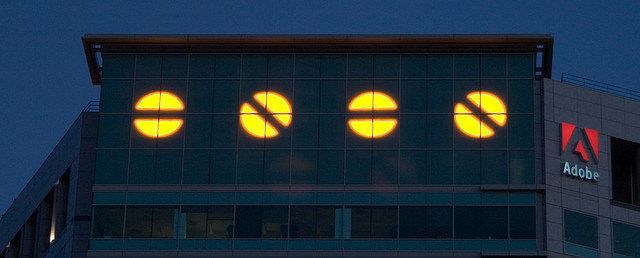
From ancient cave hieroglyphics to World War II-era cryptography, humans have always striven to crack the codes we create. Media artist Ben Rubin toys with the possibility of communication without consummation in San Jose Semaphore, a giant abstract code transmitted by the Almaden Tower in San Jose, on the modernist campus of Adobe Inc.'s headquarters.
Rubin's design is largely the same as the Semaphore he beamed onto the tower's 17th floor in 2006: an LED projection depicts four spinning wheels changing their positions every 7.2 seconds according to a code created by Rubin. Each of the bisected circles can orient vertically, horizontally, diagonally to the left, or to the right, for a total of 256 possible combinations. Six years ago, two local scientists deciphered Rubin's first message to be the complete text to Thomas Pynchon's "Crying of Lot 49."
In an email to the Huffington Post, Rubin referenced the famously cerebral author again, explaining why he's so dogged about beaming "a mystery in plain site above downtown San Jose" every few years.
"I wanted to make a piece that possessed, in the words of Thomas Pynchon, 'a hieroglyphic sense of concealed meaning, of an intent to communicate.' My hope is that when you look at the Semaphore, even if you have no idea what it is, that you wonder: is that thing trying to tell me something? Is there a message there?
Beyond the idea of code and mystery, there is something existentially human about the need and desire to connect, which is why our culture has invested so much in language, and writing, and printing, and electronic communication: all of these are expressions of our collective desire to connect across space and time.
Rubin intends for his semaphore to pay homage to a historic light-themed San Jose structure, the Electric Light Tower, which collapsed in a 1915 windstorm. The eponymous inspiration is the semaphore telegraph line designed by Claude Chappe, a wooden communication device that eventually spread through all of Europe as a precursor to modern telecommunication.
Watch the video and see the photographs below. If you feel you speak Rubin's language, head to the Semaphore website to place your decoded hypothesis. Even if you aren't the code-cracking type, there's no denying the radness of the fact that a meaningful message is being transmitted. What do you think, readers? Any guesses?
San Jose Semaphore from Ben Rubin on Vimeo.

